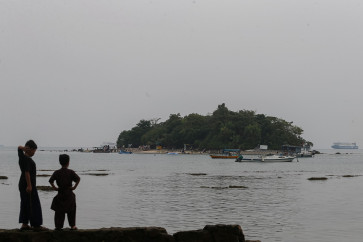Popular Reads
Top Results
Can't find what you're looking for?
View all search resultsPopular Reads
Top Results
Can't find what you're looking for?
View all search resultsUnequal growth; Java is honey pot
Indonesia’s economy grew steadily in the third quarter on robust domestic consumption, investment and exports, but concerns are rife over the unequal distribution of growth, as economic activity in Java remained the primary driver of growth
Change text size
Gift Premium Articles
to Anyone

I
ndonesia’s economy grew steadily in the third quarter on robust domestic consumption, investment and exports, but concerns are rife over the unequal distribution of growth, as economic activity in Java remained the primary driver of growth.
The economy grew by 6.5 percent in the third quarter of this year — among the highest in Asian economies — according to data released by the Central Statistics Agency (BPS) on Monday.
Java was home to 57 percent of the economy, with scant signs of that proportion shifting to other regions over the past three years despite President Susilo Bambang Yudho-yono’s repeated pledges to shrink the developmental gap between the provinces.
“Java and Sumatra still dominate the country’s economic development,” BPS balance sheet and statistical analysis deputy chairman Slamet Sutomo said.
As of the third quarter of this year, Java and Sumatra together contributed 81.3 percent to the country’s GDP, which has been the norm.
The BPS revealed a slight economic shift of focus to Sumatra and Kalimantan, both of which saw crude palm oil (CPO) and coal booms in recent years. Indonesia is the world’s largest exporter of both commodities.
Sumatra’s share of the economy grew to 23.6 percent, up from 23.1 percent in 2010 and 22.6 percent in 2009, while Kalimantan’s increased to 9.5 percent, up from 9.2 percent in 2010 and 2009.
“The developmental disparity between Java and the rest of the country is still well entrenched. The government has less interest in tapping opportunities in other regions, as can be seen in the way infrastructure is developed,” Indonesian Science Institute (LIPI) economist Latif Adam said. “Regions with abundant natural resources are struggling to export their products because they have no international ports. They’re kept in poverty.”
With Java established as the economic sweet spot, it is no surprise that talented people from the other regions relocate to the island, which is now home to 58 percent of the country’s 237 million people.
With so many flocking for jobs, the island is now among the world’s most densely populated areas. Many poor people from regions as distant as Maluku and East Nusa Tenggara — among the most underdeveloped provinces in the archipelago — are also coming in droves.
Many of them are now stranded on the streets, doing anything they can to make ends meet.
Analysts also blame the nation’s developmental discrepancies for triggering the endless bloody conflicts in Papua and other eastern regions, where poverty remains high despite the huge natural resource potentials.
“Investors are reluctant to invest in areas that have no infrastructure, despite their abundant natural resources,” Indonesian Chamber of Commerce and Industry (Kadin) deputy chairman Bambang Sujagad said.
“Business competitiveness outside Java is very low because of poor infrastructure. The logistical costs are just so expensive, with inflation usually spiking in these regions.”
But despite the fears, overall inflation continued its downward trend, reaching 4.42 percent in October, down from 7.02 percent in January, with a low benchmark borrowing rate of 6.5 percent.
“The outlook for the next six months is still bright, as Indonesia continues to enjoy an extended period of high growth and low inflation,” Eugene Leow, a Singapore-based economist at the DBS Group Research, said in a research note.
“Conditions are conducive for consumers to continue spending,” Leow’s note added.









